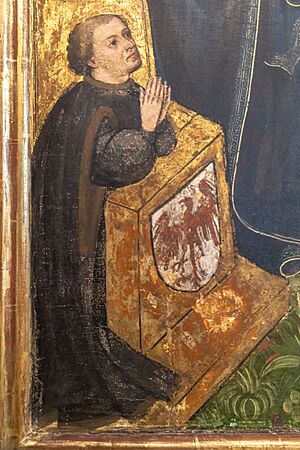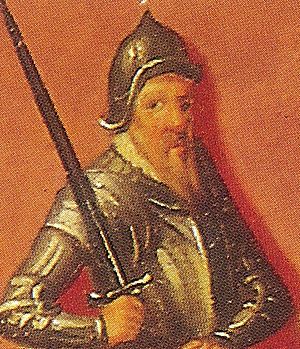Frederick I, Elector of Brandenburg facts for kids
Quick facts for kids Frederick I |
|
|---|---|

Frederick I as depicted on the Cadolzburger Altar (by the Meister des Cadolzburger Altars, c. 1425-1430)
|
|
| Elector of Brandenburg | |
| Reign | 30 April 1415 – 20 September 1440 |
| Predecessor | Sigismund of Luxembourg |
| Successor | Frederick II |
| Born | 21 September 1371 Free Imperial City of Nuremberg |
| Died | 20 September 1440 (aged 68) Cadolzburg Castle, Principality of Ansbach |
| Spouse |
Elisabeth of Bavaria-Landshut
(m. 1401) |
| Issue | Elisabeth, Duchess of Brzeg-Legnica and Cieszyn John, Margrave of Brandenburg-Kulmbach Cecilia, Duchess of Brunswick-Wolfenbüttel Margaret, Duchess of Mecklenburg Magdalene, Duchess of Brunswick-Lüneburg Frederick II, Elector of Brandenburg Albert III Achilles, Elector of Brandenburg Dorothea, Duchess of Mecklenburg Frederick, Margrave of Brandenburg |
| House | Hohenzollern |
| Father | Frederick V, Burgrave of Nuremberg |
| Mother | Elisabeth of Meissen |
Frederick (born September 21, 1371 – died September 20, 1440) was an important ruler in German history. He was the last Burgrave of Nuremberg, a title similar to a castle commander, from 1397 to 1427. He also became the Margrave of Brandenburg-Ansbach and Brandenburg-Kulmbach. Most importantly, Frederick became the very first Elector of Brandenburg from the powerful Hohenzollern family in 1415. An Elector was a prince who had the special right to vote for the Holy Roman Emperor.
Contents
Early Life and Military Service
Frederick was born in Nuremberg. He was the second son of Frederick V, the Burgrave of Nuremberg, and Elisabeth of Meissen. From a young age, Frederick served his brother-in-law, Duke Albert III of Austria.
After Albert's death in 1395, Frederick joined forces with King Sigismund of Hungary. They fought against the Ottoman army. Frederick and his older brother John fought in the Battle of Nicopolis in 1396. Sadly, they suffered a big defeat in this battle.
Political Role and Family Matters
After returning to Nuremberg, Frederick divided his family's lands in Franconia with his brother John. Frederick received the Principality of Ansbach, while John got the Principality of Bayreuth. They both shared rule over the Burgraviate of Nuremberg.
Frederick tried to help settle a dispute between King Wenceslaus and Elector Rupert III. However, he eventually sided with Rupert, who was married to Frederick's sister, Elizabeth. Wenceslaus was removed from power, and Rupert became the new King of the Romans in 1400.
Becoming an Elector of Brandenburg
Frederick took back control of Ansbach in 1409. He then began to serve King Sigismund. In 1410, the throne of the Holy Roman Empire became empty. Sigismund asked Frederick for help to become the new emperor.
At that time, Jobst of Moravia ruled Brandenburg. This meant he was one of the prince-electors who could vote for the new king. However, Sigismund believed he had the right to Brandenburg and its vote. He chose Frederick to represent him as the Elector of Brandenburg in the election on September 20, 1410.
Sigismund won this first vote. But Jobst of Moravia won the support of most electors in another election in October 1410. Jobst then claimed the imperial throne himself. When Jobst died in January 1411, Sigismund was able to reclaim Brandenburg. He was then elected king without dispute later that year.
To thank Frederick for his help, King Sigismund made him a top commander and administrator of Brandenburg in 1411. Frederick worked hard to bring order to Brandenburg. He fought against rebellious nobles, like the Quitzow family, and made the region safe again.
Ruling Brandenburg and Later Years
At the Council of Constance on April 30, 1415, Sigismund officially made Frederick the Margrave and Prince-elector of Brandenburg. On October 21, 1415, the local assembly, called a Landtag, in Berlin asked him to rule. The king formally gave him control of the margravate on April 18, 1417.
Frederick did not agree with Sigismund's harsh actions against the Hussites, a religious group. Because of this, their relationship became less friendly.
Frederick faced ongoing conflicts with the nobles of Brandenburg. In 1425, he decided to move to his castle at Cadolzburg. He handed over the rule of Brandenburg to his son, John, in 1426. However, Frederick still remained the Elector.
After 1427, Frederick helped organize the war against the Hussites. He is known for joining the papal representative Julian Cesarini in August 1431. They attacked the Hussites in the terrible Battle of Domažlice. Frederick later played a big role in helping to arrange the peace agreement, known as the Compacta of Prague, at the Council of Basel in 1433.
Frederick died in 1440. His second-eldest son, Frederick II, became the new Elector of Brandenburg.
Family and Children
Frederick married Elisabeth of Bavaria-Landshut in 1401. She was the daughter of Duke Frederick of Bavaria-Landshut. They had many children together:
- Elisabeth (1403–1449)
- John "the Alchemist" (1405–1465), who became Margrave of Brandenburg-Kulmbach.
- Cecilia (c. 1405–1449)
- Margaret (1410–1465)
- Magdalene (c. 1412–1454)
- Frederick II (1413–1471), who became Elector of Brandenburg.
- Albert Achilles (1414–1486), who also became Elector of Brandenburg.
- Sofie (born and died 1417)
- Dorothea (1420–1491)
- Frederick "the Fat" (c. 1424–1463)


